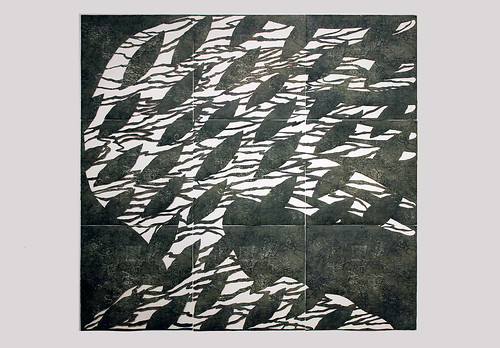Charlotte artist, Indrani Nayar-Gall "combines intaglio process with paper cutting and organic materials such as rice in new works examining the ritual traditions of her Native India."
-Edie Carpenter, Head curator at Greenhill
We were recently able to sit down and talk to Indrani about her passion for printmaking, the processes involved and the deeper message behind her captivating works.

So how did you get started with printmaking? Why this medium as opposed to other mediums?
Well, for me, I got really interested in the process. The actual making of the work is what I get into, sometimes more than the final product. The cutting, the etching, the chemical process, and working with the plate. I really love the hands on process of printmaking.
The kind of printmaking process I use is intaglio which is a process where the surface is andulated and you use an etched plate with engraved lines and everything is raised. It's not flat and I love that. With the lithograph process you draw on a plate and the oil and water don't mix, leaving an image but to me, it's too flat. I prefer the intalgio.
That's very interesting. I know that printmaking is a very hands-on process and to hear that that's what you value is understandable. So now let's talk a little about your process. What is your aesthetic and how do you go about realizing it?
Well, I'm not a formalist so my work is very context driven. I have never been able to do "art for art's sake". To me form is secondary and I speak through my art so it's all about the context and concepts. Of course my art speaks visually but it's mostly about the story and the process. I like to suggest a lot of things in my works and show social and political concepts. I want to make you question the content.
I use the ideas of tradition and change where tradition is very rigid and unchanging. I used a lot of ancient symbols and motifs that derive from Indian tradition and religion. My work talks about indoctrination and the inflexibility that tradition forces on people at times. I incorporate themes such as the inflexibility of the patriarchy, Hinduism, Islam, even Christian sects, and the subjugation of women and I want to observe these dominant systems through research. I specifically chose my own religion, Hinduism, and used Hindu symbols and ancient scripts to create overarching symbols such as the square which can be seen as a complete, whole, inflexible shape that is unwanting to change.
The square is a man made symbol whereas the tree, which I use a lot of in my works as well, is from nature and out of human jurisdiction. Sometimes, one dominates the other but I specifically wanted to talk about emancipation and the freeing of oneself from those restrictions and inflexibilites.
The idea of "homing" and "unhoming" is also very prevalent throughout my work. I wanted to bring light to the horrors of prostitution that are currently taking place in my country. I used the cutting away of leaf symbols in my prints as a symbol of nature and the idea of being freed from trapped space. I believe that nature is the opposite of human suffering.
I can see that your work is very much emotionally and socially charged. In relation to that, let's talk a bit about you use of color.
Well this is actually the first time I've used green in a while. I think of green as a referent of trees and leaves but I used a more subdued green to also emphasize and show the grave nature of the social issues. The color is almost like a grey or black and the cutting out of the shapes exposes a nonprint area which could be seen as the absence of rules. The colors are also very earthy which is traditional in India.
Do you have a broad message or central idea to your work?
Well I really wanted people to focus on the shapes and the silouhettes that I created. I'm very happy with this exhibition and although the process was physically painful at times, with the cutting, it was a very satisfying and liberating experience and I think that my pieces exude the power and feeling that I wanted to convey.
You can see more of Indrani's work here at her website or in person in our Imprint exhibition that runs through March.
